5 Ways Interactive Maps can Ease the Stress of Move-in Day
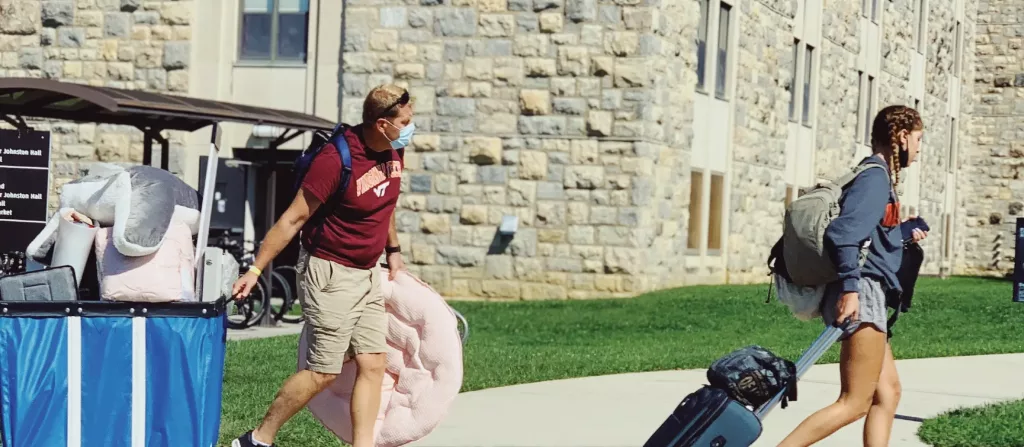
Move-in day is not just the beginning of a new academic year for most colleges; it is also one of the most crucial events in the higher ed lifecycle. A strong first day (and week) on campus can successfully pave the way to a fulfilling and memorable college experience.
From planning to execution, move-in day is a lot to handle. It can be stressful and overwhelming, and leave higher ed professionals feeling like they’ve started the year off on the wrong foot. You can, however, start yourself on the right foot with an interactive campus map tailored to move-in day.
A traditional PDF print map of your campus can only go so far. For instance, it may cover the basics of what your students need to find the right spots from a fixed point, but that kind of map is missing better virtual opportunities.
A virtual map is your all-in-one tool for move-in day success.
A recent survey by Concept3D found that incoming students’ usage of interactive maps rose from 83% to 87% once they had been accepted to that school. Another internal survey found that new and current students were the third most frequent use case for campus maps. They were only behind students researching and applying for schools.
When used the right way, interactive campus maps help make your fall 2024 move-in day a success. These five approaches show how your virtual map can help incoming students navigate the campus while taking a load off the shoulders of event organizers.
1. Allow students to get a campus overview
A college campus can be intimidating to incoming students. Finding their way around is just as much about having a general overview as it is about the wayfinding signs while they’re on their way from residence halls to the student center or academic buildings.
Your interactive map provides an easy, straightforward overview of all buildings that will be important to them, both during move-in day and for the first few weeks on campus. The best part? The whole campus can be at their fingertips. They’ll be able to:
- See the buildings that will become important to them, and how to get to them dynamically.
- Find event spaces for community building.
- Familiarize themselves with the student spaces in which clubs and activities make their home.
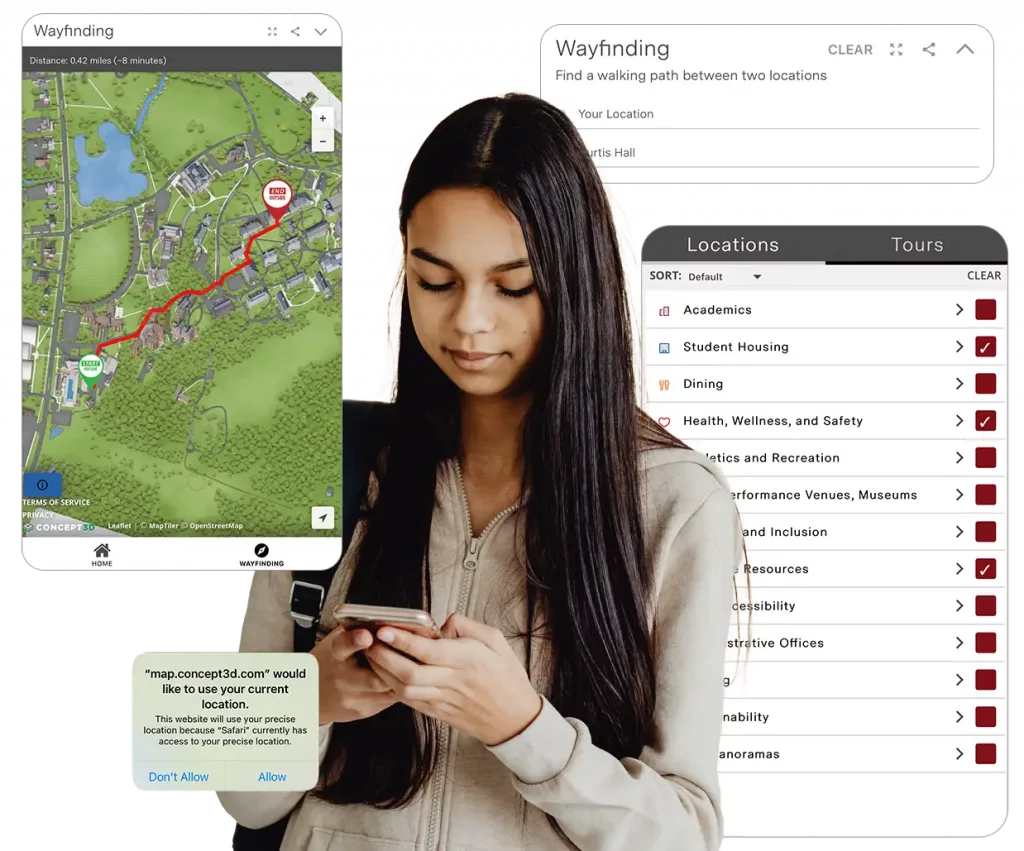
As briefly mentioned above, this overview enables first-time students to map out their way to class on the first day. Our survey found this to be the single biggest use case of interactive maps for incoming students.
A printed map, of course, can accomplish the same basic function. The added benefit of a virtual map is that colleges and universities can include more in-depth information about every space, including:
- A calendar of events for move-in day attached to the student center
- Panoramic images and videos that show what the building’s interior is like
The result is a more natural and dynamic integration into the campus layout and structure. This eases the college transition before move-in day even arrives.
2. Help students navigate campus in real time
The second-most frequent use case of an interactive map, according to our survey, is generating directions on a mobile device while navigating to class, in real time.
Whether that means walking directions through wayfinding, or benefiting from live data feeds that tell students where their bus is on its route, students can use your interactive map to get around campus, starting before they even arrive on the big day.
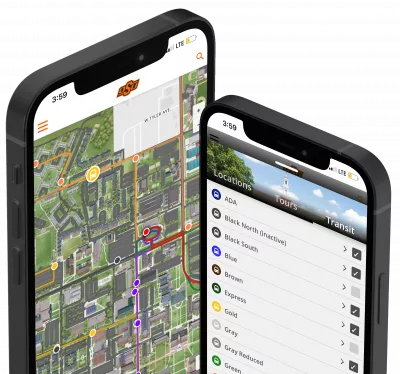
The ways they can use this map on move-in day, though, include the following:
- Basic wayfinding can help students find their way to the right move-in parking lot, check-in points, residence halls, and event spaces.
- Map tours within your interactive map give students and their families an opportunity to virtually “walk” through important landmarks or points of interest on your campus.
- Integrated, live data feeds for campus shuttles and other public transportation lets students know where to wait for their next bus stop, and where their bus is currently.
- Commonly-used routes to and from academic buildings let students easily find their way to class on time during the first day of the semester.
3. Exhibit your school’s inclusiveness
College move-in day is stressful enough for able-bodied students. For those with disabilities, however, without the tools on their side to succeed, navigating a new campus can become a nightmare.
Interactive maps can help by exemplifying the accessibility features your campus provides, from elevators in buildings to wheelchair paths on the quad.
Specific to move-in day, an interactive campus map that’s able to demonstrate how and where your accessibility lies on campus is essential. Mark wherever you have accessible entrances to the student center. You can also highlight accessible bathrooms in individual buildings or parking lots with ample amounts of handicap parking. In fact, schools can create an accessibility layer on their virtual map platform to highlight all of these opportunities in one easy-to-find spot.
The map itself can also be built with all audiences in mind. Maps optimized for screen readers add another layer of accessibility; you can also make all map navigation possible with only a keyboard. These features can also give you peace of mind that your virtual tools and website are helping you maintain accessibility requirements.
4. Provide students with extra resources
Beyond basic wayfinding and understanding the campus layout, students will have plenty of questions during and after move-in day. Your interactive map shouldn’t be the only resource for those questions. But it can point them in the right direction and make the answers easy to find.
For example, as examined by Concept3D’s partner Pathify, mental health has become an increasingly challenging topic on college campuses in recent years and in light of the COVID-19 pandemic. Your interactive map can:
- Point students in the direction of tangible help like the college counseling center
- Offer additional content (like study tips) in relevant spots like classroom buildings.
You can also introduce the increasingly common trend of classroom community building via well-placed information available on your digital and dynamic map. Events and spaces that encourage small-group interactions and common study areas may well be the subject of a map layer that is easy to find and navigate for any student looking for information.
And, of course, the map can link to extra resources available elsewhere on the university website. Through navigational structures and CTA buttons, students are able to easily navigate your institution’s website when looking for more information on a given topic. As a result, they’ll be less likely to be confused or stressed by the thousands of pages that the average university website holds.
5. Create a move-in day informational hub
Finally, don’t underestimate the importance and benefits of organizing all move-in day information in a single, convenient, mobile- and desktop-friendly location. A great way to make this happen is by creating a move-in day category on the map. Users can select this category, and have access to links and information regarding all of your communications related to the big day.
The category can live within your events navigation or as a standalone item. Either way, it allows you to highlight any number of things, including:
- All residence halls into which first-year students might be moving
- Pick up and drop off, as well as parking, for students and families moving into the residence halls
- Administrative offices that may be relevant, like public safety or key pickup offices
- Dining spots open during move-in day, which typically falls on a weekend
- Any construction on campus around which students and families might have to navigate
- Traffic patterns on campus allow arriving students to find the easiest way to where they need to go
With the right map tool, you can even build an interactive map tour. Through this, you can guide first-year students and their families through every step in the right order. From finding the right parking lot to picking up their keys, the map can be a linear guide that stays relevant until the student is fully moved in, the stress begins to recede, and the fun begins.
Want to see this in action?
1. The University of Alabama organizes all the move-in day essentials, like bus stops, important buildings, and loading and holding areas across campus in one convenient place. Plus, the bright color-coded locations and paths help the information pop off the page.
“With roughly 8,000 incoming freshmen moving into 19 dormitories and residential areas, move-in weekend can be a very confusing time at the University of Alabama. With the help of Concept3D, we have created a one-stop-shop to alleviate the stresses of “where to go” for students and their families on move-in day.”
Trey Johnson, University of Alabama
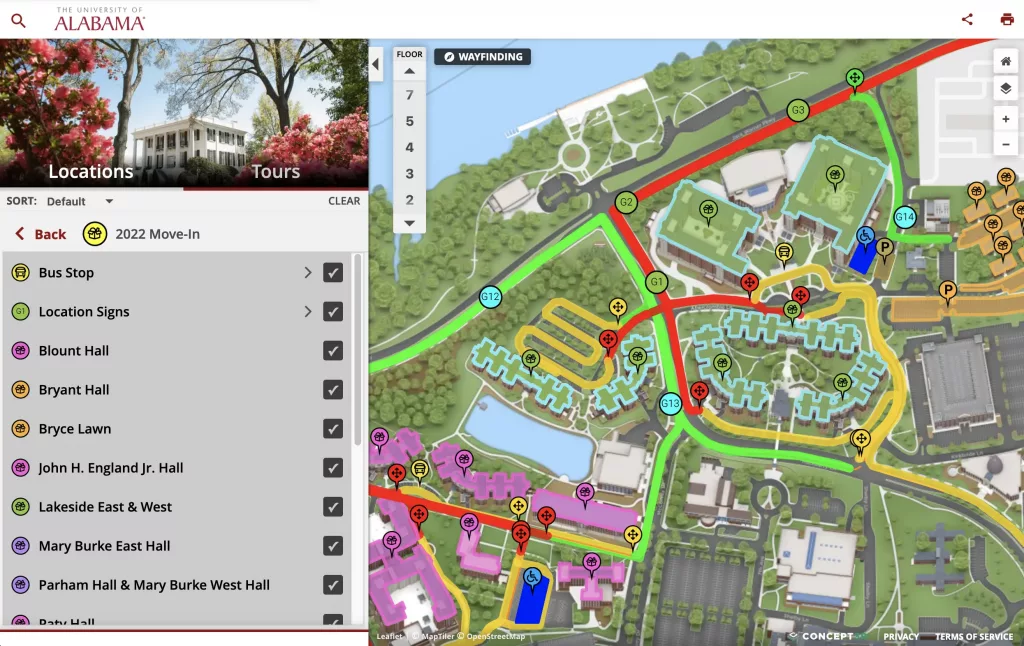
2. The University of Tennessee Knoxville uses their map to showcase their beautiful campus dynamically through the use of their Interactive Map move-in category.
“Our campus transitioned from using digital PDF maps to Concept3D interactive maps to aid our incoming students and families during move-in day. The flexibility, customization, and individualization that Concept3D maps offers streamlined the move-in day experience on our campus.”
Meghan Jagnow, UT Knoxville
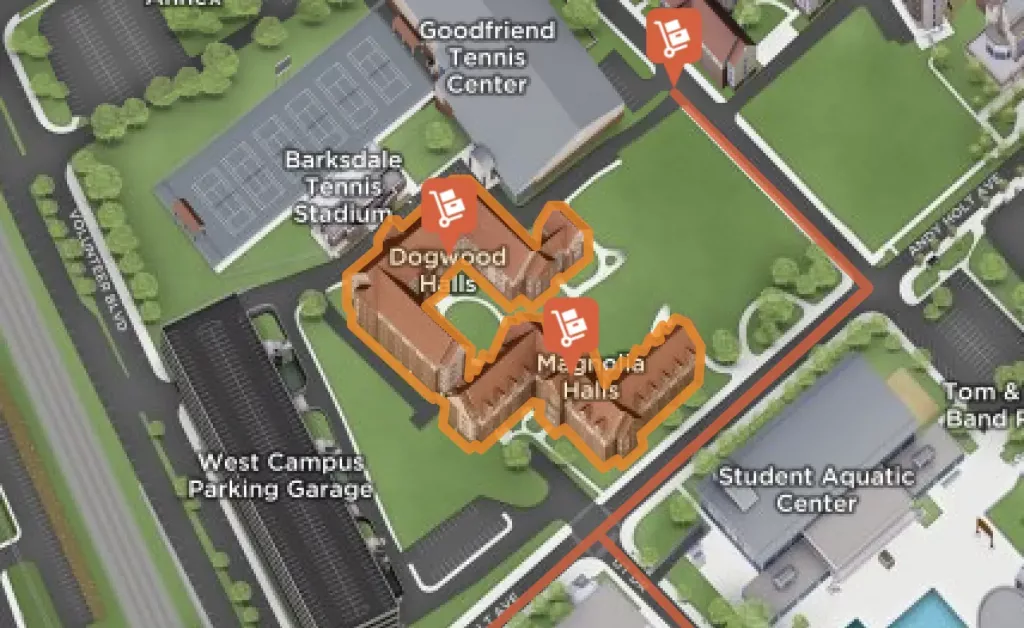
3. Framingham State University is a picturesque campus settled in eastern Massachusetts. Take a look at how they’ve created a move-in day category with Concept3D’s Interactive Maps.
“Creating a Move-In category on our map has been especially helpful for communicating traffic patterns on our small, semi-urban campus. We have sent students maps with details specific to their residence hall to minimize confusion on move-in day . . . We also highlight parking areas for parents and families who want to spend time helping their student set up their new dorm room, as well as popular spots to eat and shop for school merch while they’re here.”
Sara Mulkeen, Framingham State University
4. The University of Vermont used their Interactive Map in 2020 to highlight COVID information, social distancing information, and testing/quarantine sites. This was all during move-in, and had step-by-step instructions on their map for what to do when checking in for the big day.
Build a less stressful move-in day experience for your students in fall 2024
Move-in day will define the incoming students’ first year in college and their overall student experience. Creating the right environment is crucial. An interactive map may be just the tool to help create that environment. This can also reduce stress for any student nervous about what to do or where to go.
Of course, you do need a platform that can stand up to these challenges, enabling you to implement each of the features mentioned throughout this guide. That’s where Concept3D comes in. Contact us for more information about our interactive map platform and how universities like Framingham State University have used it to streamline their students’ move-in day experience.
Check out our on-demand webinar to learn more about how you can transform your Interactive Map for move-in day.
